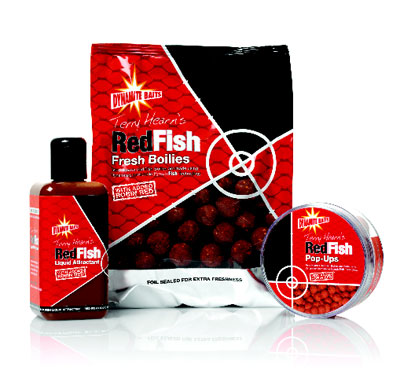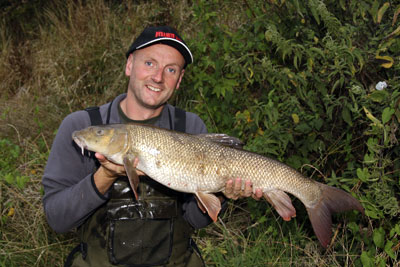It might be controversial, but in the right hands pre-baiting can be one of the most effective techniques for improving your barbel catches. At times it can make barbel ridiculously easy to catch, yet to make it work for you does need careful thought and a fair degree of application.
The biggest hurdle for most people is reconciling the commitment required to make pre-baiting work. Frequent baiting is a chore; my local river is only a 25 mile round trip, but by the time I have driven there, walked to the swim, baited up and returned home the best part of two hours has gone by. OK, there are much worse places to spend the evening, but it is still time that has to be factored in to our busy schedules.
Pre-baiting often gets a bad name because an angler comes along and simply chucks a load of bait into the going swim, killing the fishing in the process. This is probably the worst possible thing that you could do. With a bit of thought and finesse though pre-baiting can be very effective, not overly expensive and cause no disruption to other anglers. Here is my methodical approach to pre-baiting small rivers.
 Find a swim to call your own
Find a swim to call your own
Never ever pre-bait in a popular swim. For one, your chances of ever getting in there to fish are probably severely diminished, and secondly think about the poor guy that turns up the next day to fish and piles in more bait on top of yours. What you need to find is a quiet swim that holds barbel. This is often the hardest part of the whole process, as you must look beyond the well worn swims. Remember though that barbel are often very mobile, particularly at night and so you can often find areas that they frequent at night well away from their well-known day-time haunts. Normally the only way to find these swims is to trial fish them until you start catching, which can be time consuming.
Keep it quiet
Obviously once you have found a secret swim of your own and got the fish queuing up to be caught the last thing you want to do is publicise the fact. So keep it quiet, try not to open up the bank side vegetation too much and don’t leave any tell-tale bait in the margins.
Time your visits
As most of my barbel fishing is done in the evening, I like to bait up around dusk. This gives the best chance that the bait will be eaten quickly, minimising wastage. The last thing you want to do is chuck in expensive boilies only to feed the local chub population or see them washed downstream by the current.
Obviously, this might not always be convenient, and putting bait in at other times is better than nothing, but do bear in mind the higher likely wastage.
Frequency is more important than quantity
You don’t need to introduce masses of bait to get the barbel looking for it. Much more important is to introduce it regularly, and by that I mean every three days as a minimum, although every two days is much better. If you can get to the river regularly then a pound of bait in the right spot is plenty to get the barbel to accept your bait. A pound of 15mm boilies is around 250 baits, and that little lot will keep the barbel busy for quite some time.
You can bulk the bait out a bit with Marine Halibut Pellets as well. I tend to introduce a 50/50 mix of boilies and 10mm pellets to bulk out the feed and keep the cost down.
Use a bait you have confidence in
A pre-baiting campaign is no time to use a bait for the first time. You must have confidence that it is going to catch fish. Whilst there are very few bad baits out there, it all comes down to what you personally have the most confidence in using. For me this is Dynamite Bait’s Red Fish, which I know the barbel love, is highly nutritious and breaks down very quickly. Whatever you use be sure that you can get consistent supplies and stick with it.
Use bigger baits
There is a real trend in Summer barbel fishing at the moment to use really small baits, such as 6mm Marine Halibut pellets , and whilst this is very effective, I like to use considerably bigger baits for pre-baiting. The smaller the baits you introduce the higher the percentage wastage is going to be, as smaller fish, right down to minnows and baby chub, will take a share. Also the barbel have to work hard to find these mass baits, I want a bait that they can find easily.
 My standard bait is a 15mm boilie. I would actually use larger, probably 20mm baits if I could get them as freezer baits, to really cut down on the number of chub and bream. A barbel has a big mouth, particularly a double figure fish, so don’t be afraid to go really large if you are plagued by other species.
My standard bait is a 15mm boilie. I would actually use larger, probably 20mm baits if I could get them as freezer baits, to really cut down on the number of chub and bream. A barbel has a big mouth, particularly a double figure fish, so don’t be afraid to go really large if you are plagued by other species.
But the barbel on my river don’t take big baits I hear you cry! With a little pre-baiting you will soon find this isn’t the case and as they build up confidence by finding an easy meal in an area that isn’t fished they will become very catchable. Give it a week
So you are visiting the river every couple of days and feeding the barbel, when should you start fishing for them? I normally like to give a swim a minimum of a week before starting to fish it. Longer is better, but the expense starts to build up, and unless you are really local can become excessive. If your location is right you will start catching after a week and the results should get better with time.
Don’t bait heavily when you are fishing
There is no need to chuck loads of bait in when you are actually fishing, and this could prove detrimental. I like to give the fish a bit of hemp to get them searching around and then use just a handful of baits, normally on a stringer or broken up in a PVA stick to draw attention to the hook bait.
Don’t hammer the swim
All your hard work can be easily undone if you now decide to hammer the swim every night. Fish the swim once or twice a week and no more, giving it a few days of bait going in with no fishing pressure to recover between visits. If you get the balance right the fishing will continue for as long as you want it to.
The maths
So, a pound of boilies, say three times a week; that works out to about fifteen quid. Throw in a few gallons of petrol and that’s another fifteen pounds. That’s a bare minimum of £30 before you have even whet a line! Whether that is a price worth paying is up to you, but I wouldn’t want to be without this tactic in my bag of tricks, that is for sure.
Don’t get bored
Fishing one swim with one bait and one rig sometimes for several weeks might be very effective, but it can also get very tedious. Pre-baiting really isn’t the be-all and end-all of barbel fishing, just another useful tactic that can pay you back handsomely. Although the catch statistics can be very impressive, it certainly isn’t the most aesthetically pleasing way to fish, so please don’t think that this is all there is to barbel fishing. For me, much of the pleasure derived from catching a barbel after a little baiting campaign is the feeling that I have used the fish’s natural behaviour to my advantage, and in doing so come just a little bit closer to knowing my quarry. The sight of a double figure barbel recovering in the landing net is just the icing on the cake.
Dr. Paul Garner
Paul has just launched his own website. For all his latest news, blog and features go to: www.drpaulgarner.co.uk.










